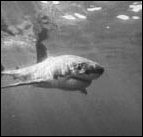 | |||||||||||
|
|
|
|
|
|
|
||||||
|
| |||||||||||
by Richard Schmidt
The following is the third of three parts of a discussion I recently had with Sean Van Sommeran, the Operations Director of the Pelagic Shark Research Foundation (PSRF) located in Santa Cruz. Rs: It sure seems there are a lot of unanswered questions with Great Whites... Sv: For generations, marine mammals have been the obvious first choice to study for biologists. They're big, dynamic, attractive, easy to acquire funding for, and they have to breathe at the surface; which makes them relatively easy to study. Whereas, sharks are more elusive and perceived to be more dangerous to work with. Rs: Have you observed Great Whites just cruising on the surface or are they mostly underneath? Sv: Yeah, they're mostly underneath, and even when they are feeding near the surface they tend to stay just out of sight, a few millimeters under. Rs: So you barely even just see a dorsal cruising like a lot of sharks do. Sv: Yeah, like Blue Sharks cruise the surface looking for vibrations, signalign prey similar to a spider web. Whereas White Sharks seem to be a lot more visual in their tracking. Their prey items are very alert and vigorous, so they have to remain quite a bit more stealthy and cryptic. For that reason, I believe they're a lot more secretive and not prone to being obvious on the surface, unless they have a mouthful of something and then it doesn't matter. They will usually just cruise under the surface. When it's glassy conditions, they're a lot easier to spot because of the boils in the water. Even so, it's interesting how camouflaged they are. Rs: I've heard that Great Whites are more abundant on this coast in the summer and fall. Sv: Actually, we've observed them only in the fall and winter with any regularity. Rs: So this is a myth? Sv: The reason for increased attacks during summer is there's simply more humans in the water, so people assume they're more abundant then. Over the past decade, people have perceived a slight increase in White Shark and human encounters. It makes sense because the marine mammal population has expanded and naturally so have the Great Whites. But what most researchers are ignoring is the fact that there are simply more and more people going into the water: jet skis, bathers, surfers, divers, sailboarders; and since there are more people out there, there's more chance for a shark to run into a human. Statistics have also shown an increase in boat crashes, people falling off cliffs, muggings up the coast, and car burglaries--just because there's more people around. The sharks are more or less constant. We may see some areas where sharks may significantly increase, but it's really theoretical. Rs: I know you fish in-between observations. Do the hooked fish ever attract a White. Sv: It's never happened to me, but I've talked to several fisherman that have observed Whites making a pass at their hooked fish and, sometimes, actually gulping it down. When Whites are younger, they eat a high abundance of fish, Rock Cod and Ling Cod, and then, when they get larger, they become more ambitious and start going after mammals. Rs: Will they tangle with a full grown Elephant Seal? Sv: Sure. Generally, the shark is always going to be bigger than the prey item, if not by much Rs: Can you kind of sense when a shark is in the area before you see it? Do mammals start scattering, or what? Sv: Not really that I've noticed. A lot of times, there will be no animals around at all which kind of makes sense. Other times we'll see 3 or 4 Sea Lions cruise right though the course line and the shark will pretty much ignore them. I think part of the shark's game plan is that they are habituating themselves to the scene, so the seals get used to them, and then, suddenly, BAM! That's when they take advantage. Rs: Do you have any advice to surfers trying not to become lunch? Sv: Surf with a buddy. It's like bears and people are in parks together all the time, and every once in a while a bear is gonna do something, and every once in a while a poacher is gonna shoot one of them. It's the law of the land... END . . .thanks for the inverview, Sean. |
| |
[ home ] | [ contact us ] | [ support us ] | [ shop ] | © Copyright 1990-2005 PSRF All rights reserved. |
Site Development by IT Director |
 Tracking Great Whites
in The Red Triangle - Part 3
Tracking Great Whites
in The Red Triangle - Part 3